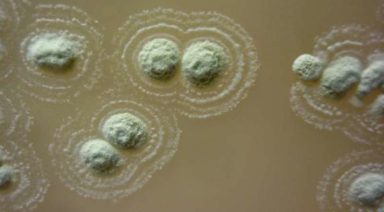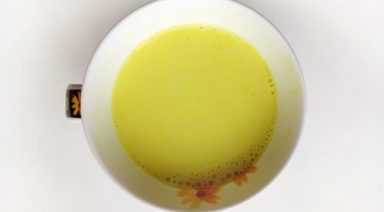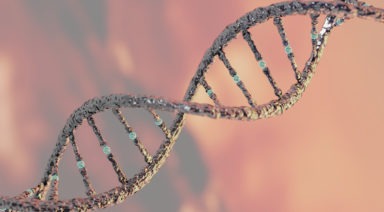Agaricus Blazei, the Healing Mushroom of the Gods

Indigenous cultures have, for millennia, included fungi in their diets and medicinal foods. Modern science is just beginning to catch up to their powerful potential. Like other potent plant healers, mushrooms are multidimensional and complex sources of nutrients that work holistically, rather than pharmacologically. Alternative medicine has experienced so much success in its employ of mushrooms to cope with an array of ailments that, at long last, modern medicine has taken notice and has funded a series of promising studies.
Now traditional oncologists and alternative practitioners alike have found success with mushrooms in patients battling cancer. Of the myriad mushroom species commonly used in traditional medicine, the Agaricus blazei has recently been the subject of numerous trials.
It is known in Brazil as “Cogumelo de Deus,” or “Mushroom of God,” because of its reputation for bestowing health and longevity on those who consume it. Although modern researchers maintain that more studies are warranted before Agaricus blazei’s medicinal value is confirmed as a curative, growing evidence, along with traditional usage, shows that a great part of its potential lies in such arenas as cancer treatment and immune system function for both humans and animals.
Agaricus Blazei Found to Have Anti-Tumor Properties
Perhaps the most exciting discovery for those suffering from cancer is that a natural substance with few, if any, side effects has the potential to fight and/or prevent disease. Because the genesis and progression of cancer is associated with a weakened immune system, it is natural to look to a powerful immune enhancer to ward off and/or kill abnormal cell growth.
Native to the Brazilian rainforest, the Agaricus blazei Murill has been used by traditional healers against cancer, infections, allergies, and a host of other maladies. When researchers began investigating this unique species, they found the mushroom to be high in immunomodulating substances that not only served to strengthen the immune system, but also induced apoptosis (cell suicide) in cancerous cells. Apoptosis is the lynchpin in cancer research, because without cell death, cancer cells continue to replicate out of control. When the effects of Agaricus blazei were studied in mouse subjects, it was found that the mushroom successfully targeted fibrosarcoma, myeloma, ovarian, lung, and prostate cancer. In human subjects, it was also found to be effective against gynecological cancer and leukemia.
In the mid-1960s, Agaricus blazei spores were taken to Japan and researched for their medicinal properties — namely their ability to fight cancer and infection. Studies on guinea pigs resulted in promising anti-tumor properties, to the extent that the Japanese began farming the mushroom and selling it on the international market. In subsequent studies, researchers successfully isolated various extracts of the mushroom, leading them to identify its polysaccharide content as the main tumor-fighting component.
While plenty of plants boast high levels of polysaccharides, Japanese studies show that the Agaricus blazei has a stronger antitumor activity than other medicinal mushrooms lauded for their cancer-fighting characteristics. One study demonstrated that a low-molecular weight polysaccharide found in Agaricus blazei was able to significantly slow, and even decrease, the spread of metastatic cells in models.
When used as an aid to patients undergoing radiation and chemotherapy cancer treatments, Agaricus blazei has been found to be a powerful adjunctive therapy for reducing side effects. Along with numerous accounts of anecdotal evidence given by oncologists, veterinarians, and patients, a clinical report from South Korea confirmed that the mushroom dispels, or at least dramatically reduces, the side effects of chemotherapy. Agaricus blazei has also been found to offer significant support to radiation treatment, which work by indiscriminately destroying both good and rogue body cells in the cancerous region. Due to its immune-boosting function, the mushroom works to produce the natural killer cells (NK) that chemotherapy and radiation commonly destroy.
Agaricus blazei Supplementation
The native peoples of Brazil have been consuming Agaricus blazei as a dietary staple for thousands of years, but those who don’t have easy access to it are wont to purchase the mushroom in supplement, tincture, or powder form.
Although Agaricus blazei and other potent healing mushrooms have been deemed important food treatments in the fight against cancer and other diseases, users should keep at least one common-sense warning in mind: When consuming this or any food or supplement — especially for a desired effect upon a serious physical ailment — the wisest course is to first consult with a physician versed in the use of medicinal mushrooms.
Agaricus blazei Murill is one of a growing number of ancient plants that hold the key to addressing many of our most common maladies. It has come out of the indigenous healer’s medicine chest and into the modern research laboratory to at long last reveal its healing secrets.
Disclaimer: All information, content, and material of this website is for informational purposes only and is not intended as a substitute for the consultation, diagnosis, and/or medical treatment of a qualified physician or healthcare provider.
Ancient Medicine Berberine Could Help with Leaky Gut Syndrome

Many call it “leaky gut.” Researchers and health practitioners call it “increased intestinal permeability,” “dysbiosis,” or “hyperpermeable intestine,” but no matter how you name it, leaky gut syndrome could be the jumping-off point for a huge range of “first-world” diseases. Leaky gut syndrome could be responsible for eczema and psoriasis, autoimmune diseases including multiple sclerosis and rheumatoid arthritis, acne, irritable bowel syndrome, and Crohn’s disease to name a very few.
Symptoms of leaky gut include diverse complaints including acne, cramps, gas, bloating, allergies, joint pain, brain fog, memory loss, or fatigue. Taken alone, any one of these symptoms may indicate a number of conditions, but when they show up in combination, and the root cause cannot be determined, it might pay off to explore leaky gut syndrome. Trying to treat symptoms when the underlying cause is leaky gut can be frustratingly unsuccessful.
There’s a way out, and research is showing that along with dietary changes and probiotics, recovery can be significantly potentiated with berberine, an ancient plant medicine.




































